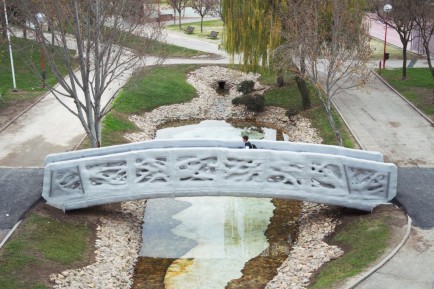
Located in Alcobendas (Madrid), the structure is claimed to be the world’s very first 3D printed bridge to be made entirely of reinforced concrete.
OK, so maybe it’s not the world’s tallest, highest, widest, longest or most spectacularly located of pedestrian bridges. But it is the first of its kind anywhere on Earth and was hailed as ‘a milestone’ by the local authorities in the Spanish town of Alcobendas – a few kilometres north of Madrid – where it was recently inaugurated.
Intrigued to find out just what’s so special about it, then? Yep, so were we…
Spanning a water feature in the town’s Castilla-La Mancha Park, and measuring 12 metres long by 1.75 metres wide, what does set this structure so decidedly apart is the fact that it’s claimed to be the world’s very first 3D printed bridge to be made entirely of reinforced concrete. There is currently a 3D printed bridge under construction in Amsterdam, but that’s made of stainless steel instead.
Designed by the Barcelona-based Institute of Advanced Architecture of Catalonia (IAAC), the Alcobendas bridge comprises eight separate sections and took 18 months to complete, with Spanish conglomerate Acciona responsible for the 3D printing process itself. As the innovative technique completely does away with the need for traditional moulds, formwork and joints, with no design restrictions imposed on them, the architects were free to create this unique structure resembling organic forms such as twisting roots and branches.
So, after 3D printed bridges, what next? 3D printed houses perhaps? Well, why not! As IAAC’s academic director Areti Markopoulou points out, “In the future, 3D printing will allow construction that is faster, cheaper and more sustainable”, all of which augurs well.
Indeed, as we speak, Dutch Studio DUS Architects are already working on their own 700m2 3D Print Canal House project which, they say, will revolutionise the building industry as well as offering new tailor-made housing solutions.
Watch this space…
 en
en



 Vlaams-Nederlands
Vlaams-Nederlands
0 Comments
Leave a Comment
DISCLAIMER
The opinions and comments expressed by contributors to this Blog are theirs alone and do not necessarily reflect the views of VIVA Homes Under the Sun Ltd, any of its associated companies, or employees; nor is VIVA to be held responsible or accountable for the accuracy of any of the information supplied.
Have you got something to say?